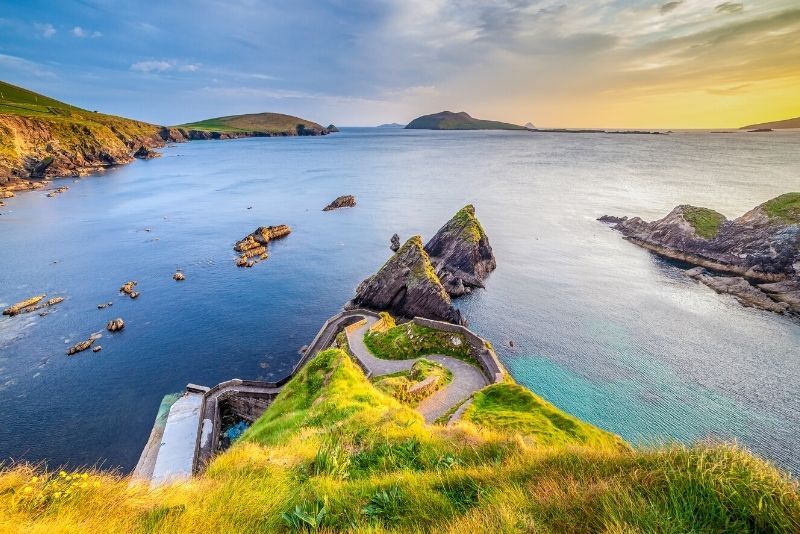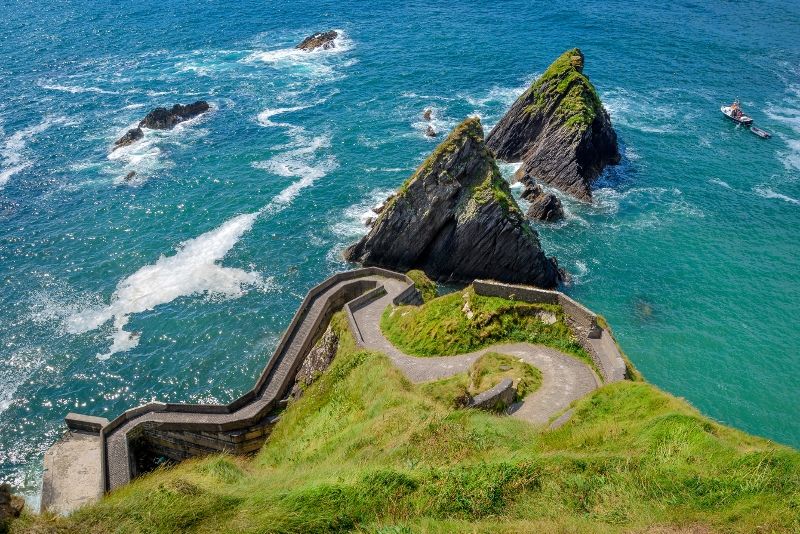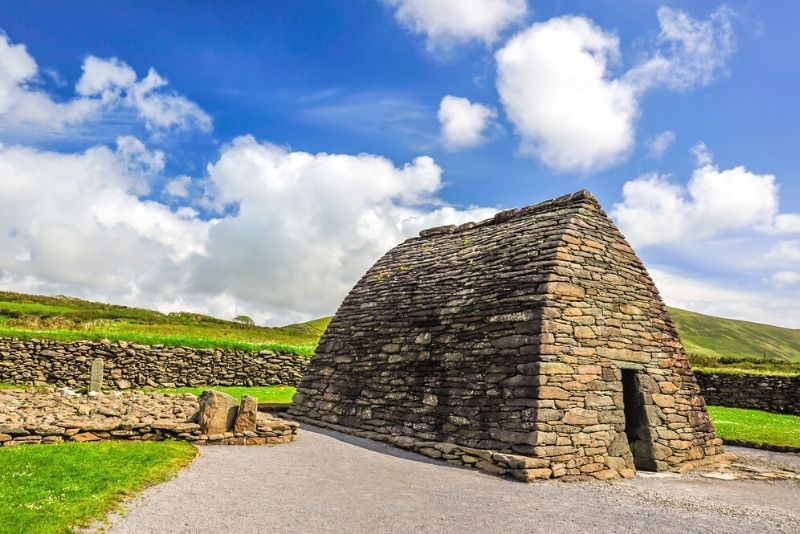Dingle Peninsula: Multi-day Trips and Tours from Dublin
The Dingle Peninsula is a small but mighty region of Ireland that features some of the most extraordinary scenery in the country. It’s also home to numerous quaint villages, memorable drives and rugged beaches.
The area is steeped in Gaelic history and is a true reflection of the real Ireland.
The Dingle Peninsula is a small but mighty region of Ireland that features some of the most extraordinary scenery in the country. It’s also home to numerous quaint villages, memorable drives and rugged beaches.
The area is steeped in Gaelic history and is a true reflection of the real Ireland.

(0/24) checking Musement...
The Dingle Peninsula is a small but mighty region of Ireland that features some of the most extraordinary scenery in the country. It’s also home to numerous quaint villages, memorable drives and rugged beaches.
The area is steeped in Gaelic history and is a true reflection of the real Ireland.
If you want to explore Dingle and be in easy reach of other hotspots in southern Ireland such as Killarney, consider a multi-day trip to the Dingle Peninsula from Dublin.

How to get to the Dingle Peninsula from Dublin?
The Dingle Peninsula is on the southwest coast of the Republic of Ireland. It is one of the main peninsulas within County Kerry and ends at Dunmore Head which is the most westerly point in the country.
From Dublin to Dingle Peninsula by car
All drives in southern Ireland are easy due to the small number of motorways, and the journey to the Dingle Peninsula is no exception. It takes just over four hours to cover the almost 350-kilometer stretch.
You'll take the M50 out of the city and follow the M7 as far as Limerick. You'll then change to the M20, before following the N86 all the way through the Dingle Peninsula and into Dingle itself.
From Dublin to Dingle Peninsula by public transport
In order to make the jaunt to the Dingle Peninsula via public transport, you need to make use of both buses and trains. You'll take a train from Dublin's Heuston station to Tralee.
This journey takes approximately four hours and costs between €24 and €35. You'll then take a bus from Casement Station to Dingle which takes another hour and costs between €9 and €12.
Guided tour to Dingle Peninsula from Dublin
Multi-day trips to the Dingle Peninsula that travel by train meet at Dublin's Heuston station at 7 AM. Tours that travel by coach have various meeting points, but all are easy to reach destinations in the center of the city. Start times are between 8 AM and 8:30 AM.
Each Dingle Peninsula excursion lasts a different amount of time, and you'll be dropped back to the same departure point once your adventure is over.
What is the typical itinerary of a multi-day tour to the Dingle Peninsula from Dublin?
Dingle Peninsula multi-day trips begin in the center of Dublin and head in a southwest direction towards the region. Itineraries vary between tours, but you can expect to stop at some of the most renowned landmarks along the way.
The Cliffs of Moher and the town of Dingle itself are always visited, and you'll also usually see some if not all of the Ring of Kerry.
Some tours will travel to the same hotel each night, but it's more common to stay at different accommodations along the route.

What kinds of tours are available to go to Dingle Peninsula?
The variety of multi-day tours to the Dingle Peninsula allows you to choose an excursion based on the free time you have to explore the region.
3-Day tour to Dingle Peninsula from Dublin
The shortest multi-day trip to the Dingle Peninsula is a 3-day tour and visits several of Ireland's most scenic and fascinating points.
On the first day, you'll travel to Glendalough Monastic Settlement, as well as the Rock of Dunamase, Kilcullen and Adare. You'll rest overnight in Dingle before spending the following day exploring the Dingle Peninsula.
You'll travel along the scenic Slea Head Drive, stopping at interesting spots along the way. After another night in Dingle, you'll slowly make your way back to Dublin. On the journey, you'll stop at Inch Beach, Torc Waterfall, Killarney and the Rock of Cashel.
4-Day tour to Dingle Peninsula from Dublin
Four-day trips to the Dingle Peninsula travel via a combination of coach and train. On the first day, you'll journey by rail to Cork from Dublin, where you'll explore Blarney Castle and Gardens, before continuing on to the historic town of Cobh.
For each night of the tour, you'll stay in a B&B in Killarney. Other notable sites you'll experience during the tour are the Ring of Kerry, the Cliffs of Moher and various parts of the Dingle Peninsula.
7-Day trip to Dingle Peninsula from Dublin
This Dingle Peninsula 7-day itinerary is packed full of adventure and includes a steep hike at Annascaul, a 4x4 off-road ride to a secret viewpoint and a boat trip to the Skellig Islands.
You'll also visit the most famous sites in Ireland, including Blarney Castle and Gardens, and the Cliffs of Moher.
You'll stay at a different local hotel every night on your loop of the country. It is a small group tour, numbering just four participants which helps to create close connections quickly.
How much does a tour to Dingle Peninsula from Dublin cost?
Three-day tours cost €547 and include two nights of accommodation, as well as a professional driver guide. You'll be part of a small group with no more than 16 participants. Meals and admission fees are at your own expense.
Four-day tours to the Dingle Peninsula include pre-arranged train travel with reserved seating and a host to provide you with any help you need. Three nights accommodation with breakfast is also included, as well as a driver-guide for the parts of the tour that take place on a coach.
You'll pay €949 for the tour and you can choose to upgrade your hotel room for €99 per person per night.
For a multi-day tour of the Dingle Peninsula that lasts a week, you'll pay €1,525 per person. The price includes six nights accommodation, breakfast, a tour guide and any relevant train rides.
What will you see and do in the Dingle Peninsula?
Slea Head Drive

Slea Head Drive is a must-do when visiting the Dingle Peninsula in Ireland. This 46-kilometer stretch of road starts and ends in Dingle, and takes you past some of the most incredible scenery in the country. This includes the iconic Blasket Islands, Conor Pass and Dunmore Head.
Along the way, there are plenty of opportunities to stop and explore, whether it's hiking to the top of Mount Brandon or enjoying a leisurely walk along the beach. You can drive the entire loop without stopping in just under an hour.
The Blasket Islands

The Blasket Islands are a group of six isles just off the west coast of Ireland. They are well known for their natural beauty and their history, and the islands were inhabited by a community of people until the mid-20th century.
In 1954, the last residents were evacuated because of concerns over the lack of emergency services access and the aging population. Today, the islands are uninhabited, but they are still popular tourist destinations.
They are a well-known spot for their connections to great Irish writers, including Robin Flower and Kenneth H. Jackson who sought refuge on the islands.
Passenger ferries make the short 20-minute crossing and only run during the summer months.
Gallarus Oratory

Gallarus is one of the most well-preserved historical sites in Ireland. Built in the early Christian period, the Oratory is a small stone structure with a distinctive curved shape.
Despite its simple appearance, the Oratory is a fascinating site that provides insights into the lives of early Christians in Ireland. Visitors to the Oratory can see remains of ancient Christian crosses and graves, along with a well that was used for baptismal ceremonies.
The Oratory is located near some of Ireland's most jaw-dropping coastline and is surrounded by wildflowers, making it the perfect place for a scenic stroll. The site is open between 9 AM and 8 PM daily, and the entrance fee is €4 for adults.
When is the best time to visit the Dingle Peninsula?
The Dingle Peninsula sees temperatures that climb to just 16 degrees Celsius during the summer months. There is little rain from June to September, so choosing these months will secure you the best weather.
Alternatively, take a multi-day tour of the Dingle Peninsula during mid-March when the St. Patrick's Day celebrations are in full swing throughout Ireland.
Are there any tours to Dingle Peninsula from other cities in Ireland?
Yes, there are other tours departing from other cities in Ireland:
Travel tips
- Make sure you book your Dingle Peninsula multi-day trip in advance, as most tours take place in small groups with very limited numbers.
- The weather in Ireland can be unpredictable, so carry a rain jacket and umbrella with you whenever possible.
- Some multi-day excursions have restrictions on the baggage you can bring with you. Check your individual provider's limitations before traveling.
